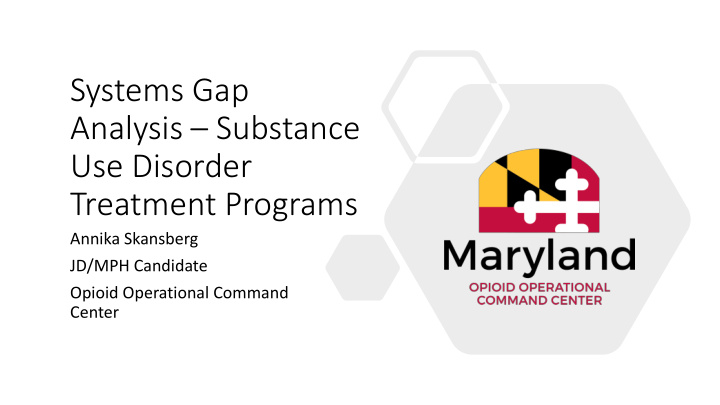



Systems Gap Analysis – Substance Use Disorder Treatment Programs Annika Skansberg JD/MPH Candidate Opioid Operational Command Center
The Substance Use Epidemic in Maryland
Gaps Analysis Objectives Evaluate the current treatment capacity for individuals with substance use disorders in Maryland counties and regions Ensure that individuals with substance use disorders in Maryland can access effective, evidence-based treatment Inform counties and regional leadership on areas where they are lacking services, and areas where they have a surplus of services
Variations of Treatment Programs – Levels of Care
Methods A systems gap analysis Use of Anne Formulas Sources of Data is a method of assessing Arundel, the differences in Wicomico, and performance within a system in order to Frederick County assess outcomes in as Statewide relation to optimal Standards service provision
Results • The largest gaps were observed in Baltimore City and Baltimore County • Many counties in the state have near- and optimal treatment coverage with minimal gaps based on our analysis • Caroline County, Charles County, Analysis Dorchester County, Montgomery County, and Talbot County
• In some instances, counties may want to consider regional solutions for expanding services to maximize individual resources Regional • .The regions are classified as: (1) Western Maryland (Washington County, Allegany County); (2) Southern Maryland (Calvert County, Charles County, St. Mary’s County); (3) Treatment Central Maryland (Baltimore City, Baltimore County, Anne Arundel County, Howard County, Harford County, Carroll County); (4) Eastern Capacity Shore (Cecil County, Queen Anne’s County, Caroline County, Talbot County, Dorchester County, Somerset County, Wicomico County, Worcester County); (5) Capital Region (Frederick County, Prince George’s County, Montgomery County
• There are identified treatment gaps for every level of service in Central Maryland • Western Maryland’s greatest treatment needs are residential services for levels 3.3-3.7 care Regional • The Eastern Shore’s analysis indicates an Treatment increased need for residential services Capacity • The Capital Region’s greatest needs are levels 3.1 and 3.7 residential treatment • Southern Maryland seemingly has sufficient treatment capacity, with the exception of level 3.1 treatment
Allocation of Resources
The use of Anne Arundel County, Wicomico County, and Classification of beds Frederick County as the by their highest level of comparison counties licensure rather than developing statewide standards Limitations through other methods with Analysis Some counties house national-level This analysis does not treatment facilities that account for payor type are licensed for a large number of beds
Include the development of a new statewide standard using other methods Future Research on Development of an alternative way to Substance Use classify treatment programs since many are licensed for multiple levels of care Disorder Treatment Incorporate more data into their calculations Capacity Research how treatment facilities are being utilized within each county
Recommend
More recommend